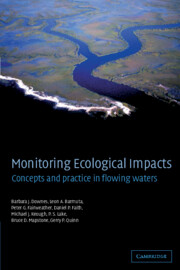Book contents
- Frontmatter
- Contents
- Preface and Acknowledgements
- Part I Introduction to the nature of monitoring problems and to rivers
- Part II Principles of inference and design
- Part III Applying principles of inference and design
- 8 Applying monitoring designs to flowing waters
- 9 Inferential uncertainty and multiple lines of evidence
- 10 Variables that are used for monitoring in flowing waters
- 11 Defining important changes
- 12 Decisions and trade-offs
- 13 Optimization
- 14 The special case of monitoring attempts at restoration
- 15 What's next?
- References
- Index
11 - Defining important changes
Published online by Cambridge University Press: 21 August 2009
- Frontmatter
- Contents
- Preface and Acknowledgements
- Part I Introduction to the nature of monitoring problems and to rivers
- Part II Principles of inference and design
- Part III Applying principles of inference and design
- 8 Applying monitoring designs to flowing waters
- 9 Inferential uncertainty and multiple lines of evidence
- 10 Variables that are used for monitoring in flowing waters
- 11 Defining important changes
- 12 Decisions and trade-offs
- 13 Optimization
- 14 The special case of monitoring attempts at restoration
- 15 What's next?
- References
- Index
Summary
In previous chapters we have referred to the ‘effect size’ of an impact. This refers to the size of the change in a variable that constitutes the greatest level of acceptable change. We therefore need to define what sort of change is important in the context of the question being asked. We avoid the term ‘significant change’ in this context to prevent confusion with ‘statistical significance’. In formal terms this is the amount of departure of the data from the null hypothesis (i.e. that the potential impact has resulted in no important change in the variable) that we need to observe before we favour the alternative hypothesis (i.e. that the potential impact has resulted in an important or unacceptable change in the variable).
To those who are new to environmental monitoring and assessment, speaking of ‘important’ or ‘acceptable’ changes in a variable seems like a form of newspeak: a euphemism covering a failure of will on behalf of the scientists or managers who should really be insisting on ‘no change’ in the variable in question. In the next section we justify why effect sizes need to be specified at all. This then leads us, in subsequent sections, to discuss the kinds of change we may need to detect, the risks and consequences of setting effect sizes, and then some practical guidelines on how we can set ‘effect sizes’ or ‘important changes’ in rivers and streams.
- Type
- Chapter
- Information
- Monitoring Ecological ImpactsConcepts and Practice in Flowing Waters, pp. 306 - 322Publisher: Cambridge University PressPrint publication year: 2002



